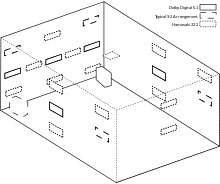22.2 surround sound
22.2 or Hamasaki 22.2 (named after Kimio Hamasaki, a senior research engineer at NHK Science & Technology Research Laboratories in Japan) is the surround sound component of Super Hi-Vision (a new television standard with 16 times the pixel resolution of HDTV). It has been developed by NHK Science & Technical Research Laboratories. It uses 24 speakers (including two subwoofers) arranged in three layers.[1]
Channels

Diagram of three major multichannel audio formats: 5.1, 9.2 and 22.2 channel layouts.
The channel numbers and labels are:[2]
| AES Pair No./Ch No. |
Channel No. |
Label | Name |
|---|---|---|---|
| 1/1 | 1 | FL | Front left |
| 1/2 | 2 | FR | Front right |
| 2/1 | 3 | FC | Front center |
| 2/2 | 4 | LFE1 | LFE-1 |
| 3/1 | 5 | BL | Back left |
| 3/2 | 6 | BR | Back right |
| 4/1 | 7 | FLc | Front left center |
| 4/2 | 8 | FRc | Front right center |
| 5/1 | 9 | BC | Back center |
| 5/2 | 10 | LFE2 | LFE-2 |
| 6/1 | 11 | SiL | Side left |
| 6/2 | 12 | SiR | Side right |
| 7/1 | 13 | TpFL | Top front left |
| 7/2 | 14 | TpFR | Top front right |
| 8/1 | 15 | TpFC | Top front center |
| 8/2 | 16 | TpC | Top center |
| 9/1 | 17 | TpBL | Top back left |
| 9/2 | 18 | TpBR | Top back right |
| 10/1 | 19 | TpSiL | Top side left |
| 10/2 | 20 | TpSiR | Top side right |
| 11/1 | 21 | TpBC | Top back center |
| 11/2 | 22 | BtFC | Bottom front center |
| 12/1 | 23 | BtFL | Bottom front left |
| 12/2 | 24 | BtFR | Bottom front right |
Channel numbers up to 6 represent the same as those in a 5.1 channel system. There are then a further 5 listener-plane channels, 9 overhead channels, arranged in a square, and a row of 3 further channels at the bottom front, plus the additional LFE channel.
Demonstrations
- Expo 2005, Aichi, Japan
- NAB Show 2006, Las Vegas, US
- IBC 2006, Amsterdam, Netherlands
- IBC 2008, Amsterdam, Netherlands[3]
- NAB Show 2009, Las Vegas, US
- IBC 2010, Amsterdam, Netherlands
- IBC 2011, Amsterdam, Netherlands
- 2012 Summer Olympics, Bradford/Glasgow/London, UK[4]
Reviews
See also
References
- ↑ "22.2 Multichannel Audio Format Standardization Activity" (PDF). NHK World. Retrieved February 17, 2014.
- ↑ "Ultra High Definition Television - Audio Characteristics And Audio Channel Mapping For Program Production". Society of Motion Picture and Television Engineers. 2008. SMPTE ST 2036-2:2008.
- ↑ Sangani, Kris (2008-10-11). "A game of leapfrog". Engineering & Technology. 3 (17): 8. doi:10.1049/et:20081720. Retrieved 2008-10-31.
- ↑ Sweney, Mark (2011-08-28). "BBC plans to use 3D and 'super hi-vision' for London Olympics". The Guardian. London.
External links
- 22.2 Multichannel Sound System for Ultra High-Definition TV article at the Wayback Machine
- 22.2 Standardization of Multichannel Sound System Japanese article at the Wayback Machine
This article is issued from Wikipedia - version of the 9/29/2016. The text is available under the Creative Commons Attribution/Share Alike but additional terms may apply for the media files.